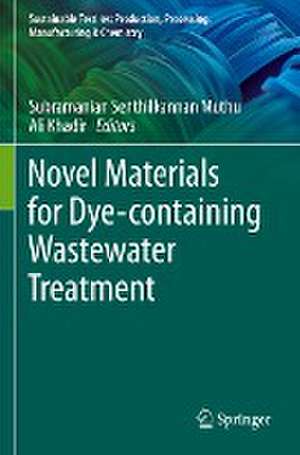Novel Materials for Dye-containing Wastewater Treatment: Sustainable Textiles: Production, Processing, Manufacturing & Chemistry
Editat de Subramanian Senthilkannan Muthu, Ali Khadiren Limba Engleză Paperback – 17 iul 2022
| Toate formatele și edițiile | Preț | Express |
|---|---|---|
| Paperback (1) | 694.04 lei 6-8 săpt. | |
| Springer Nature Singapore – 17 iul 2022 | 694.04 lei 6-8 săpt. | |
| Hardback (1) | 947.85 lei 6-8 săpt. | |
| Springer Nature Singapore – 16 iul 2021 | 947.85 lei 6-8 săpt. |
Din seria Sustainable Textiles: Production, Processing, Manufacturing & Chemistry
- 24%
 Preț: 778.71 lei
Preț: 778.71 lei - 18%
 Preț: 726.37 lei
Preț: 726.37 lei - 20%
 Preț: 567.99 lei
Preț: 567.99 lei - 20%
 Preț: 692.85 lei
Preț: 692.85 lei - 18%
 Preț: 790.28 lei
Preț: 790.28 lei - 18%
 Preț: 1002.61 lei
Preț: 1002.61 lei - 18%
 Preț: 951.29 lei
Preț: 951.29 lei - 18%
 Preț: 781.62 lei
Preț: 781.62 lei - 18%
 Preț: 895.45 lei
Preț: 895.45 lei - 15%
 Preț: 583.93 lei
Preț: 583.93 lei - 15%
 Preț: 637.46 lei
Preț: 637.46 lei - 15%
 Preț: 575.77 lei
Preț: 575.77 lei - 15%
 Preț: 576.09 lei
Preț: 576.09 lei - 15%
 Preț: 578.05 lei
Preț: 578.05 lei - 15%
 Preț: 637.78 lei
Preț: 637.78 lei - 15%
 Preț: 579.34 lei
Preț: 579.34 lei - 15%
 Preț: 701.72 lei
Preț: 701.72 lei - 15%
 Preț: 642.64 lei
Preț: 642.64 lei - 18%
 Preț: 948.79 lei
Preț: 948.79 lei - 15%
 Preț: 575.09 lei
Preț: 575.09 lei - 15%
 Preț: 696.68 lei
Preț: 696.68 lei
Preț: 694.04 lei
Preț vechi: 816.51 lei
-15% Nou
Puncte Express: 1041
Preț estimativ în valută:
132.82€ • 144.22$ • 111.57£
132.82€ • 144.22$ • 111.57£
Carte tipărită la comandă
Livrare economică 22 aprilie-06 mai
Preluare comenzi: 021 569.72.76
Specificații
ISBN-13: 9789811628948
ISBN-10: 9811628947
Ilustrații: VII, 229 p. 80 illus., 59 illus. in color.
Dimensiuni: 155 x 235 mm
Greutate: 0.34 kg
Ediția:1st ed. 2021
Editura: Springer Nature Singapore
Colecția Springer
Seria Sustainable Textiles: Production, Processing, Manufacturing & Chemistry
Locul publicării:Singapore, Singapore
ISBN-10: 9811628947
Ilustrații: VII, 229 p. 80 illus., 59 illus. in color.
Dimensiuni: 155 x 235 mm
Greutate: 0.34 kg
Ediția:1st ed. 2021
Editura: Springer Nature Singapore
Colecția Springer
Seria Sustainable Textiles: Production, Processing, Manufacturing & Chemistry
Locul publicării:Singapore, Singapore
Cuprins
Dye pollution in water and wastewater.- The Utilization of Biomaterials for Water Purification: Dyes, Heavy Metals, and Pharmaceuticals.- Chitosan, a promising bio material for dye elimination.- Removal of Rifampin by Luffa: A Pharmaceutical Potential in Producing Dye in Water.- Ability To Remove Azo Dye From Textile Dyeing Wastewaters Of Carbonaceous Materials Produced From Bamboo Leaves.- Current treatment of textile dyes using potential adsorbents: mechanism and comparative approaches.- Nanocellulose-based membranes for the removal of dyes from aquatic systems.- TiO2-based Composites for Water Decolorization.- Dye degradation by recent promising composite.
Notă biografică
Dr. Subramanian Senthilkannan Muthu currently works for SgT Group as Head of Sustainability, and is based out of Hong Kong. He earned his PhD from The Hong Kong Polytechnic University, and is a renowned expert in the areas of Environmental Sustainability in Textiles & Clothing Supply Chain, Product Life Cycle Assessment (LCA) and Product Carbon Footprint Assessment (PCF) in various industrial sectors. He has five years of industrial experience in textile manufacturing, research and development and textile testing and over a decade's of experience in life cycle assessment (LCA), carbon and ecological footprints assessment of various consumer products. He has published more than 100 research publications, written numerous book chapters and authored/edited over 100 books in the areas of Carbon Footprint, Recycling, Environmental Assessment and Environmental Sustainability.
Ali Khadir is an environmental engineer and a member of the Young R^ 4,including Journal of Environmental Chemical Engineering and International Journal of Biological Macromolecules. He also has been the reviewer of journals and international conferences. His research interests center on emerging pollutants, dyes and pharmaceuticals in aquatic media, advanced water and wastewater remediation techniques and technology. At present, he is editing other books for Springer in the field of nanocomposites, advanced materials, and the remediation of dye – containing wastewaters.
Ali Khadir is an environmental engineer and a member of the Young R^ 4,including Journal of Environmental Chemical Engineering and International Journal of Biological Macromolecules. He also has been the reviewer of journals and international conferences. His research interests center on emerging pollutants, dyes and pharmaceuticals in aquatic media, advanced water and wastewater remediation techniques and technology. At present, he is editing other books for Springer in the field of nanocomposites, advanced materials, and the remediation of dye – containing wastewaters.
Textul de pe ultima copertă
This book highlights novel materials for dye-containing wastewater treatment and presents an up-to-date information on dye degradation/adsorption using new promising materials such as nanocomposites. Development of various industrial sectors, including textile, food, paper, leather, rubber, cosmetic and printing has led to generation of wastewater which contain dye molecules as well as other inorganic and organic compounds. Considering serious health hazards and environmental damage associated with dyes in the environment, researchers and professionals have been attempting to find the most effective methods of treatment. Of late, various composites have received wide attention due to their outstanding properties in wastewater treatment, that are presented in this book.
Caracteristici
Presents an in-depth and holistic approach to advancements in dye removal Highlights a range of promising materials for dye-containing waste water treatment Includes interesting topics such as semiconductors composites, carbon - based materials, titanium dioxide in dye removal and promising biomaterials including chitosan, nanocellulose and Luffa for dye elimination
